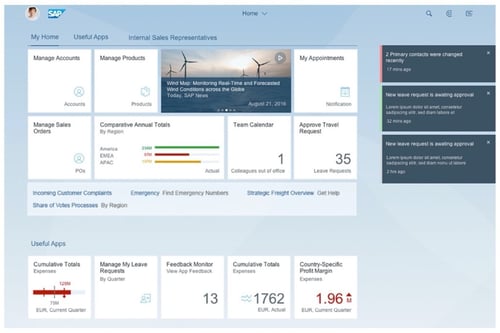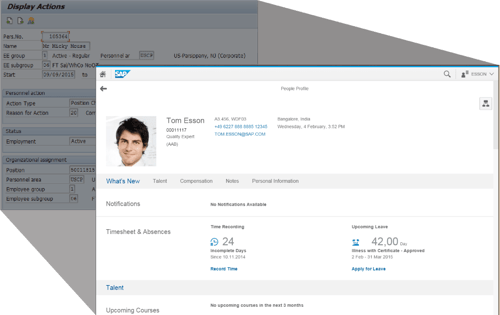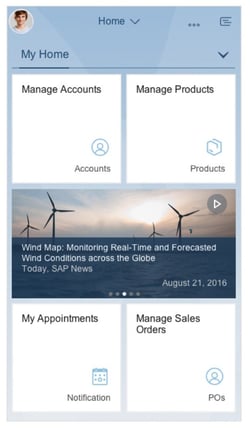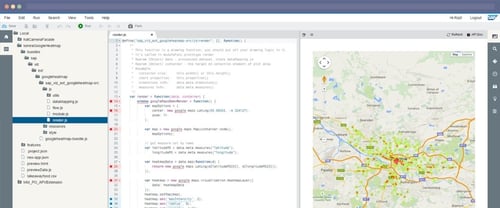What is SAP Fiori?
Fiori is a platform for delivering modern web-based applications for SAP. Fiori was developed by SAP over the last several years and is replacing SAP GUI as the main user interface for SAP starting with S4/HANA.
Rather than entering transactions in a single, monolithic SAP GUI, separate Fiori relies on separate mini apps for different business tasks like creating sales orders or approving timesheets. Fiori applications can be personalized across user roles, lines of business, tasks and devices. Based on customer input, SAP designed Fiori user experience with user friendliness and flexibility to work across a variety of devices including desktop, tablets and smartphones.
Fiori Launchpad is a centralized “home page” that hosts all available Fiori mini-apps for a given department or even the entire company. Fiori Launchpad provides Fiori apps with configuration, navigation and personalization services, along with embedded support.

Each square (called “tile”) represents a separate Fiori business application, which is launchable by the user. Tiles display according to the user’s role and indicate live statuses, such as how the number of open tasks, approvals, service tickets etc.
Ultimately, there’s a night and day difference between the SAP GUI and Fiori experience. While SAP GUI is bulky and hard to learn or train on, Fiori has the seamless movements and controls you would expect out of any modern web application. Fiori screens are simple, customizable and fresh, without the unnecessary tabs and fields that SAP GUI had.

Benefits of Adopting Fiori
As with any new technology, there are several key benefits that drive its adoption and offset the expenses in deploying and retraining people to use it. Below are some of the more important benefits that we have observed among our customer base:
1) Increased Productivity – Fiori is designed around productivity. Common tasks are organized in a streamlined, intuitive workflow that optimizes clicks and typing time to completion.
In one side-by-side comparison between Fiori and SAP GUI, SAP had a collections specialist contact a customer, remind them about a payment due and register their issue with an invoice. In SAP GUI, the process took 2:12, and required 39 clicks, eight screen changes and five fields filled. For comparison, In Fiori it took just 11 clicks, 2 screen changes and 2 filled fields to complete the process. And most importantly, it only took 47 seconds — a 64% decrease in duration.
2) Intuitive Workflows – What do accounting, marketing, fulfillment and human resources have in common? They’re not IT. Aside from a few jobs like SAP Basis and SAP security, most of the business roles in your company should not require technical knowledge of SAP’s interworkings, but historically end users had to understand how SAP structured its internal workflow to use it.
With Fiori, user workflows are built around business processes, not SAP logic. That makes life easier for your workforce, particularly for non-technical users. As a side benefit, you don’t have to weigh SAP experience as highly when hiring new talent in non-IT roles.
3) Ready for Mobility – Mobile workforce is growing at a rapid place. By 2022, an estimated 42.5% of the global workforce will be mobile, and that number will likely grow in the future. Fiori’s mobility and responsive design help companies adapt to this new distributed model, allowing users to access essential work apps from anywhere and on any device. Across industries and job titles, mobile apps allow workers, managers and executives to be more responsive, while still maintaining a satisfying work-life balance.
Fiori’s mobile capabilities are particularly useful in applications that require a high degree of freedom like warehouse or manufacturing where employees often work from the factory floor. Mobile sales and service can likewise benefit from up to date product and pricing information as well as better ability to upsell or cross sell.

4) Workforce Flexibility – Fiori’s standardized interface and coherent design philosophy let workers quickly learn new jobs and roles. Once users understand the basic way Fiori apps are structured, they can transfer that knowledge to all other Fiori apps. This makes it easier to shift workers to new positions and harness their skills more effectively. It also lets you change the way roles are filled in to meet organization-specific needs by adding or removing tasks from different user roles.
How much does Fiori cost?
Fiori is licensed as part of the SAP Gateway license, which in turn is part of the SAP NetWeaver license. If your company already uses NetWeaver Gateway, there is no additional cost to implement or deploy standard FIORI apps.
If NetWeaver Gateway is not an option for your on-premise solution, a good alternative is to run Fiori in SAP Cloud Platform and connect to your on-premise SAP system using SAP Cloud Connectors. When using Fiori cloud and cloud connectors, the costs model is similar to other cloud providers like Google and Amazon, where costs are incurred on per usage basis (e.g. the more you use, the more you pay).
Adopting Fiori
Flexibility and configurability have always been strengths of SAP. SAP has always provided tools that reach across the full range of industries and use cases, as well as provides companies the ability to adapt third party tools or create their own custom solutions as required.
With the wider adoption of Fiori (and SAP HANA in general), customers have less and less need to build their own custom solutions. The Fiori library now has thousands of apps, covering a huge range of business cases in both ECC Suite and S/4HANA. SAP’s third-party partnerships, and its Apple partnership in particular, have led to a massive infusion of new talent into the SAP ecosystem. Vibrant Fiori app ecosystem also means that there are fewer situations where companies must develop their own in-house solutions from scratch. This is fantastic news for businesses with complex or novel workflows, as projects can start with installing an existing Fiori app provided by SAP or a vendor and customize it to fit the company specific business scenario.
Fiori Journey
In our experience, most companies go through 3 distinct stages in their journey to adopt Fiori: “Dip your toes”, “Business Acceptance” and “Scale”.
- Stage 1, “Dip your Toes” is all about learning and trying Fiori for the first time. The best place to start is Fiori Apps Library. It contains thousands of ready to run Fiori reference applications that cover a wide range of business processes.
Most companies usually start with the help of Fiori consulting company that guides them through installing a few of the reference apps from the Apps Library. Once everybody gets some experience with what is generally available, the next step is to pick an existing (simple) business process and build a real proof-of-concept that can be used by a small group of employees (instead of using SAP transactions and SAP GUI directly). - Stage 2, “Business Acceptance” usually involves converting a (more) complex business process (like HR onboarding or CapEX management) into a set of one or multiple Fiori Applications. This is where companies usually start seeing some of the limitations of “out of the box” Reference Fiori apps due to the need for more and more customization. At the beginning of this stage, it is also beneficial to take step back and look critically at the business process you are trying to automate – does it really require all the current steps? Is it missing something? Design Thinking is a good approach at this stage to explore and reengineer the business process before building the new Fiori apps around it.
- Stage 3, “Scale”. Once Fiori has shown proven benefits, many departments will be looking to use it to reengineer their business processes. This increased demand puts pressure on IT department to deliver more, and more complex Fiori applications. Properly scaling IT or internal development teams requires investing in tools, usually “low code”, Fiori Rapid Development environments (like Fiori AppBuilder) that can help drastically increase the productivity of development organizations to meet the increased demand.
Building Custom Fiori Applications
SAP provides a complete toolset for designing, building and deploying Fiori apps. Most Fiori application development is done using SAP Web IDE - Fiori’s enterprise-ready UI development toolkit. It is based on SAPUI5 with support for HTML5 and JavaScript.
Web IDE also allows developers to extend or customize existing Fiori applications (like the Fiori reference apps downloaded from Fiori App Library).

SAP Web IDE is the preferred and recommended tool by SAP for customizing the Out-Of-the-Box FIORI apps delivered by SAP. For building custom application using SAPUI5 toolkit, in addition to using Web IDE, customers have a choice of using Eclipse or HANA Studio with the SAPUI5 plugin. SAP Web IDE is a great development tool and is relatively inexpensive – it available for $54/month for 5 users
Ready to try Fiori in your organization?
Developed to meet new enterprise IT criteria, SAP designed Fiori to be available on demand in the cloud and on-premises. When it comes to Fiori deployment options, admins have five basic choices:
- Fiori Front End Server (FES) embedded deployment, where Fiori is embedded in a single SAP landscape, is the simplest deployment option. It is best for situations where there is a single Fiori instance running.
- Fiori Front End Server (FES) Hub deployment, which bundles the Fiori UI components, SAP Launchpad and SAP Gateway. Business logic and traditional UIs stay on the back end, so you can integrate multiple back end systems like SAP CRM and SRM.
- Gateway embedded, where the SAP Gateway is embedded in the back end, which makes it possible to integrate cloud FES instances with a cloud connector.
- Gateway hub, here SAP Gateway serves as a hub – making it easy to connect the backend with FES in the cloud
- SAP Fiori Cloud, with FES in the cloud on a standalone basis. It connects to back end systems that are on-premises.
Regardless how Fiori is deployed, when adopting Fiori apps, it is helpful to keep in mind some of the architectural principles underpinning the Fiori platform:
- Central Access to apps through the Fiori launchpad – supporting personalization, navigation and configuration
- Security with single sign-on (SSO) as well as role-based authentication and authorization
- Open Data Protocol (OData), which facilitates secure provisioning and data consumption.
- Built-in support for detailed usage analytics. Analytics data helps discover how employees use various apps as well what performance impact each app has on the overall enterprise infrastructure.
Architectural principles above, if followed properly, make Fiori very versatile. They also ensure that tasks are not tied to a specific device, session or user. For example, users can start creating a service order on their desktop and exit the app before completing it. Later, they can resume work on the same service order from their mobile device. Fiori infrastructure will automatically save data asynchronously and allow users to even hand off partially completed tasks to other users to complete.
For large majority of organizations, adoption of Fiori is a matter of time as both technology trends and SAP itself are putting a large amount of efforts to increase Fiori adoption. Having a solid strategy for introducing Fiori across the enterprise is good way to stay ahead of the technology and competition curves.



